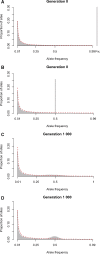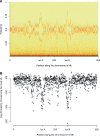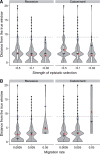Finding Hybrid Incompatibilities Using Genome Sequences from Hybrid Populations
- PMID: 34097068
- PMCID: PMC8476132
- DOI: 10.1093/molbev/msab168
Finding Hybrid Incompatibilities Using Genome Sequences from Hybrid Populations
Abstract
Natural hybrid zones offer a powerful framework for understanding the genetic basis of speciation in progress because ongoing hybridization continually creates unfavorable gene combinations. Evidence indicates that postzygotic reproductive isolation is often caused by epistatic interactions between mutations in different genes that evolved independently of one another (hybrid incompatibilities). We examined the potential to detect epistatic selection against incompatibilities from genome sequence data using the site frequency spectrum (SFS) of polymorphisms by conducting individual-based simulations in SLiM. We found that the genome-wide SFS in hybrid populations assumes a diagnostic shape, with the continual input of fixed differences between source populations via migration inducing a mass at intermediate allele frequency. Epistatic selection locally distorts the SFS as non-incompatibility alleles rise in frequency in a manner analogous to a selective sweep. Building on these results, we present a statistical method to identify genomic regions containing incompatibility loci that locates departures in the local SFS compared with the genome-wide SFS. Cross-validation studies demonstrate that our method detects recessive and codominant incompatibilities across a range of scenarios varying in the strength of epistatic selection, migration rate, and hybrid zone age. Our approach takes advantage of whole genome sequence data, does not require knowledge of demographic history, and can be applied to any pair of nascent species that forms a hybrid zone.
Keywords: epistasis; genetic incompatibilities; hybrid zone; site frequency spectrum.
© The Author(s) 2021. Published by Oxford University Press on behalf of the Society for Molecular Biology and Evolution.
Figures




Similar articles
-
Selection leads to remarkable variability in the outcomes of hybridisation across replicate hybrid zones.Mol Ecol. 2024 Jun;33(11):e17359. doi: 10.1111/mec.17359. Epub 2024 May 3. Mol Ecol. 2024. PMID: 38699787
-
Using Pool-seq to Search for Genomic Regions Affected by Hybrid Inviability in the copepod T. californicus.J Hered. 2018 May 11;109(4):469-476. doi: 10.1093/jhered/esx115. J Hered. 2018. PMID: 29329459
-
Evidence of natural selection acting on a polymorphic hybrid incompatibility locus in Mimulus.Genetics. 2015 Feb;199(2):543-54. doi: 10.1534/genetics.114.171819. Epub 2014 Nov 25. Genetics. 2015. PMID: 25428983 Free PMC article.
-
The genetics of hybrid incompatibilities.Annu Rev Genet. 2011;45:331-55. doi: 10.1146/annurev-genet-110410-132514. Epub 2011 Sep 6. Annu Rev Genet. 2011. PMID: 21910629 Review.
-
The role of conflict in shaping plant biodiversity.New Phytol. 2023 Dec;240(6):2210-2217. doi: 10.1111/nph.19233. Epub 2023 Sep 4. New Phytol. 2023. PMID: 37667567 Free PMC article. Review.
Cited by
-
Understanding brewing trait inheritance in de novo Lager yeast hybrids.mSystems. 2024 Dec 17;9(12):e0076224. doi: 10.1128/msystems.00762-24. Epub 2024 Nov 12. mSystems. 2024. PMID: 39530669 Free PMC article.
-
Imbalanced segregation of recombinant haplotypes in hybrid populations reveals inter- and intrachromosomal Dobzhansky-Muller incompatibilities.PLoS Genet. 2022 Mar 28;18(3):e1010120. doi: 10.1371/journal.pgen.1010120. eCollection 2022 Mar. PLoS Genet. 2022. PMID: 35344560 Free PMC article.
-
Population Genomics of Giant Mice from the Faroe Islands: Hybridization, Colonization, and a Novel Challenge to Identifying Genomic Targets of Selection.Genome Biol Evol. 2025 Jul 30;17(8):evaf141. doi: 10.1093/gbe/evaf141. Genome Biol Evol. 2025. PMID: 40650889 Free PMC article.
-
Rapid and predictable genome evolution across three hybrid ant populations.PLoS Biol. 2022 Dec 20;20(12):e3001914. doi: 10.1371/journal.pbio.3001914. eCollection 2022 Dec. PLoS Biol. 2022. PMID: 36538502 Free PMC article.
References
-
- Barton N, Bengtsson B.. 1986. The barrier to genetic exchange between hybridising populations. Heredity 57(3):357–376. - PubMed
-
- Barton N, Hewitt G.. 1985. Analysis of hybrid zones. Annu Rev Ecol Syst. 16(1):113–148.
-
- Bateson W.1909. Heredity and variation in modern lights. In: Seward AC, editor. Darwin and Modern Science. Cambridge: Cambridge University Press. p. 85–101.
Publication types
MeSH terms
Grants and funding
LinkOut - more resources
Full Text Sources
Other Literature Sources
Research Materials

